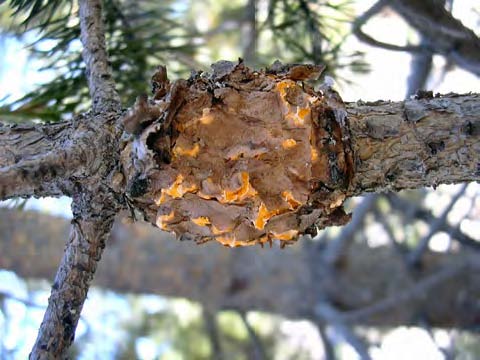PESTS AND DISEASES OF FORESTRY IN NEW ZEALAND
New paper on western gall rust
Scion is the leading provider of forest-related knowledge in New Zealand
Formerly known as the Forest Research Institute, Scion has been a leader in research relating to forest health for over 50 years. The Rotorua-based Crown Research Institute continues to provide science that will protect all forests from damage caused by insect pests, pathogens and weeds. The information presented below arises from these research activities.
From Forest Health News 205, May 2010.
We have published a paper on the specific method that we developed to detect the DNA of the western gall rust pathogen within infected host tissue. Peridermium harknessii (syn. Endocronartium harknessii) has long been viewed as a potential risk to exotic radiata pine plantations in the southern hemisphere because, unlike most rust pathogens, an alternate host is not required to complete the lifecycle. This means that P. harknessii is able to spread directly from pine to pine.
The impact of infection can range from volume loss due to branch galls, through to mortality due to stem breakage at a stem gall. Wood quality can also be affected due to characteristic “hip-cankers” on the stem.

The pathogen is not present in New Zealand. It takes a long time to produce spores and this method was developed so that the pathogen could be identified prior to sporulation and potential spread. If the pathogen can be detected before sporulation, the probability of successful eradication is much higher.
In addition to the DNA markers that we developed, we used the DNA sequence generated during the study to analyse the relationships between P. harknessii and its closest relatives. This analysis, utilising a portion of the genome that has not been used for the gall rusts before, confirmed earlier work that Cronartium quercuum f. sp. banksianae is the closest relative to P. harknessii. This means that P. harknessii is either an autoecious derivative of C. quercuum f. sp. banksianae or that they share a recent common ancestor.
One of the rewarding aspects of this work is that we were able to investigate a fundamental science question while developing a practical tool that can be used by MAF Biosecurity New Zealand and other regulatory agencies.
For further information on western gall rust and the risk that it poses to New Zealand, see:
Ramsfield, T.D., Kriticos, D.J., Vogler, D., and Geils, B. 2007. Western gall rust – a threat to Pinus radiata in New Zealand. New Zealand Journal of Forestry Science 37:143-152. A copy of this paper can be downloaded from http://www.scionresearch.com/general/sciencepublications/science-publications/nzjfs/previousvolumes/issue-37.
Ramsfield and Vogler 2010: “A DNA-based method for detection of Peridermium harknessii, the causal agent of western gall rust”. Australasian Plant Pathology 39: 247– 253. Copies of this paper can be obtained from http://www.australasianplantpathologysociety.org.au/ or from the author (tod.ramsfield @scionresearch.com).
Tod Ramsfield
This information is intended for general interest only. It is not intended to be a substitute for specific specialist advice on any matter and should not be relied on for that purpose. Scion will not be liable for any direct, indirect, incidental, special, consequential or exemplary damages, loss of profits, or any other intangible losses that result from using the information provided on this site.
(Scion is the trading name of the New Zealand Forest Research Institute Limited.)

 Farm Forestry New Zealand
Farm Forestry New Zealand

